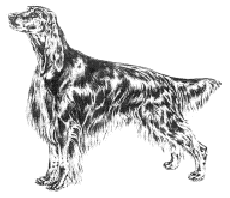Irish Setter
General Information - Irish Setter

Group:
Gundog
Size:
large
Lifespan:
12-14 years
Exercise:
very high
Grooming:
medium
Trainability:
medium
Watchdog ability:
high
Protection ability:
very low
Area of Origin:
Ireland
Date of Origin:
1700s
Other Names:
Red Setter
Original Function:
Bird setting and
retrieving
History
The ancestry of the Red Setter hailing from Ireland is a mystery. Some suggest that the Irish Setter may descend from crosses between the Irish Water Spaniel, the English and Gordon Setters, some Pointers and perhaps the Bloodhound. By the 18th Century, the Red and White Setter was well-established in Ireland, and through successive breedings, the mahogany version was developed. The breed was originally used as a hunting companion and in the sport of falconry. The Irish Setter was one of the most popular show dogs of the late 19th Century. The elegant, active, and beautiful Irish Setter makes a lovable addition to the family, as long as it has outdoor activity every day.
Temperament
Lovable, energetic and sweet tempered, Irish Setters are excellent family dogs. Highly affectionate and intelligent, they are good with children. Irish Setters must be trained at an early age to prevent the development of bad habits. They are wonderful dogs and considered as a joy to own.
Upkeep
The Irish needs exercise, and lots of it. It is not fair to take a dog selected for boundless energy and expect it to sit inside. A minimum of one hour of hard strenuous games and exertion a day is recommended. Because of its energy, it is not suited as an apartment dog. It can live outside in temperate or warm weather, but it needs warm shelter and needs to come inside in colder weather. It is such a sociable dog that it does best living with its family. The coat needs regular brushing and combing every two to three days, plus some clipping and trimming to looks its best.
Irish Setter
A breed standard is the guideline which describes the ideal characteristics, temperament, and appearance of a breed and ensures that the breed is fit for function with soundness essential. Breeders and judges should at all times be careful to avoid obvious conditions and exaggerations, as well as being mindful of features which could be detrimental in any way to the health, welfare or soundness of this breed.
Breed Standard - Irish Setter
 General Appearance:
General Appearance: Must be racey, full of quality and kindly in expression.
Head and Skull: The head should be long and lean, not narrow or snipy and not coarse at the ears. The skull oval (from ear to ear), having plenty of brain room and with well:defined occipital protuberance. Brows raised, showing stop. The muzzle moderately deep and fairly square at end. From the stop to the point of the nose should be long, the nostrils wide and the jaws of nearly equal length, flews not to be pendulous.
Colour of the Nose: Dark mahogany, or dark walnut, or black.
Eyes: Should be dark hazel or dark brown and ought not to be too large.
Ears: The ears should be of moderate size, fine in texture, set on low, well back; and hanging in a neat fold close to the head.
Mouth: Not over or undershot.
Neck: Should be moderately long, very muscular, but not too thick, slightly arched, free from all tendency to throatiness.
Forequarters: The shoulders to be fine at the points, deep and sloping well back. The chest as deep as possible, rather narrow in front. The forelegs should be straight and sinewy, having plenty of bone, with elbows free, well let down, not inclined either in or out.
Body: Should be proportionate, the ribs well sprung, leaving plenty of lung room. Loins muscular, slightly arched .
Hindquarters: Should be wide and powerful. The hind legs from hip to hock should be long and muscular; from hock to heel short and strong. The stifle and hock joints well bent and not inclined either in or out.
Feet: Should be small, very firm, toes strong, close together and arched.
Tail: Should be of moderate length, proportionate to the size of the body, set on rather low, strong at root and tapering to a fine point; to be carried as nearly as possible on a level with or below the back.
Coat and Feathering: On the head, front of the legs and tips of the ears, should be short and fine, but on all other parts of the body and legs it ought to be of moderate length, flat and as free as possible from curl or wave. The feather on the upper portion of the ears should be long and silky; on the back of fore and hind legs should be long and fine; a fair amount of hair on the belly, forming a nice fringe, which may extend on chest and throat. Feet to be well feathered between the toes. Tail to have a nice fringe of moderately long hair, decreasing in length as it approaches the point. All feathering to be as straight and as flat as possible.
Colour: The colour should be rich chestnut, with no trace whatever of black; white on chest, throat, chin or toes, or a small star on the forehead, or a narrow streak or blaze on the nose or face not to disqualify.
Note: Male animals should have two apparently normal testicles fully descended into the scrotum.
DNZ No 336
Copyright Dogs New Zealand
01 Jan 2002
Any departure from the foregoing points should be considered a fault and the seriousness with which the fault should be regarded should be in exact proportion to its degree and its effect upon the health and welfare of the dog and on the dog’s ability to perform its traditional work.




